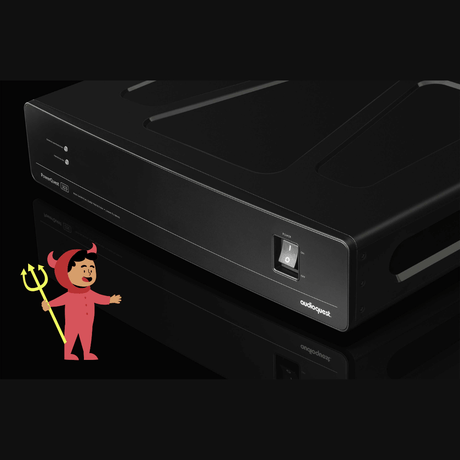
Scientist Says PowerQuest 303 is "Evil!"
Jürgen Krauss, founder of AudioReviews.org, is a scientist. What does he make of high-performance power conditioning? PURE EVIL.
RCA > Kabel gramofonowy RCA + przewód uziemiający
Często wybór pomiędzy zakończeniem kabli głośnikowych za pomocą widełek spadowych a wtykami bananowymi sprowadza się do osobistych preferencji. Jednak zgodne z normami UE izolowane zaciski stosowane w niektórych wzmacniaczach mocy często utrudniają, jeśli nie uniemożliwiają, dokręcenie widełek spadowych z dużym momentem obrotowym lub naciskiem. W takich przypadkach złącze bananowe AudioQuest jest lepszym wyborem, a może być jedynym wyborem.
AudioQuest przeprowadziło dość szerokie badanie współczesnych producentów wzmacniaczy, aby określić, czy widełki czy banany będą najbardziej odpowiednie dla danej marki i modelu wzmacniacza. Prosimy skontaktuj się z nami, podaj markę i model wzmacniacza, a my odpowiemy z optymalnym typem złącza.
W tym przypadku zazwyczaj zalecamy złącze U-Spade lub bananowe. Jednak mimo że po tej stronie kabla jest mniej wagi i nacisku (szczególnie w przypadku zestawów BiWire), ważne jest, aby zwrócić uwagę na konstrukcję zacisku. Jeśli złącze bananowe nie może być w pełni osadzone w zacisku, zalecamy jedno z naszych złączy spadowych.
Solidne przewodniki z miedzi o doskonałej powierzchni (PSC)
Od początku, AudioQuest był pionierem w wykorzystaniu lepszych metali, jednak nawet my byliśmy zaskoczeni ogromnym skokiem wydajności osiągniętym dzięki zadziwiająco gładkiej i czystej powierzchni miedzi o doskonałej powierzchni (PSC). Własna technologia przetwarzania metalu chroni powierzchnię drutu na każdym etapie ciągnienia i produkcji. Gdy miedź o wysokiej czystości i niskiej zawartości tlenków jest utrzymywana w jak najmiększym, najczystszym i najgładszym stanie, staje się wspaniałym przewodnikiem o niskim poziomie zniekształceń. W konwencjonalnym kablu, interakcja elektryczna i magnetyczna między żyłami jest jednym z największych źródeł zniekształceń, często powodując nieco szorstki, brudny dźwięk. Solidne przewodniki są podstawą do osiągnięcia bardzo czystego, naturalnego dźwięku.
Rozpraszanie hałasu warstw metalowych
Łatwo jest osiągnąć 100% pokrycie ekranu. Zapobieganie modulacji odniesienia ziemi sprzętu przez przechwycone zakłócenia radiowe (RFI) wymaga technologii AQ Noise-Dissipation. Tradycyjne systemy ekranowania zazwyczaj pochłaniają i następnie odprowadzają energię hałasu/RF do ziemi komponentu, modulując i zniekształcając krytyczną "referencyjną" płaszczyznę ziemi, co z kolei powoduje zniekształcenie sygnału. Noise-Dissipation "ekranuje ekran", pochłaniając i odbijając większość tej energii hałasu/RF, zanim dotrze do warstwy przymocowanej do ziemi.
Izolacja z piankowego polietylenu
Każdy stały materiał sąsiadujący z przewodnikiem jest w rzeczywistości częścią niedoskonałego obwodu. Izolacja drutu i materiały płytki drukowanej pochłaniają energię. Część tej energii jest magazynowana, a następnie uwalniana jako zniekształcenie. Ponieważ powietrze prawie nie pochłania energii, a polietylen jest materiałem o niskich stratach i ma łagodny profil zniekształceń, Foamed-PE, z wysoką zawartością powietrza, powoduje znacznie mniejszy efekt rozmycia typowy dla innych materiałów.
Przewodniki o kontrolowanym kierunku
Wszystkie ciągnione żyły metalowe lub przewodniki mają niesymetryczną, a zatem kierunkową, strukturę ziaren. AudioQuest kontroluje wynikową zmienność impedancji RF, aby hałas był odprowadzany z miejsca, gdzie powodowałby zniekształcenia. Prawidłowy kierunek jest określany poprzez odsłuch każdej partii przewodników metalowych używanych w każdym kablu audio AudioQuest. W razie potrzeby, strzałki są wyraźnie oznaczone na złączach, aby zapewnić doskonałą jakość dźwięku. W większości modeli kabli AQ, strzałki nie tylko wskazują kierunek, który optymalizuje kierunkowość metalu jako część Noise-Dissipation, ale również wskazują niesymetryczne połączenie ekranu i GND, aby zoptymalizować wydajność całego systemu. Podstawowy aspekt wieloaspektowej technologii Noise-Dissipation AudioQuest, Przewodniki o kontrolowanym kierunku zapewniają właściwe rozpraszanie i odprowadzanie indukowanego hałasu.
Zimno-zgrzewane, złocone zakończenia
Ten projekt wtyczki pozwala na połączenie pozbawione cyny, która jest powszechnym źródłem zniekształceń. Zamiast cyny, proces wykorzystuje technikę wysokiego ciśnienia. Ponieważ obudowy uziemienia są tłoczone zamiast obrabiane mechanicznie, metal użyty może być wybrany ze względu na niskie zniekształcenia, a nie łatwość obróbki.